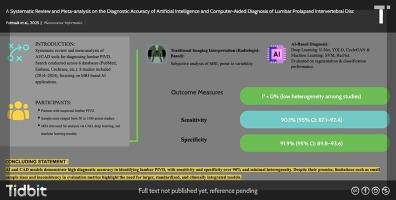人工智能和计算机辅助诊断腰椎间盘突出症诊断准确性的系统回顾和荟萃分析
引用次数: 0
摘要
腰椎间盘突出症(PIVD)是一种使腰背部衰弱的疾病,准确及时的诊断对其有效治疗至关重要。人工智能(AI)和计算机辅助诊断(CAD)技术有可能通过提高准确性、效率和客观性来彻底改变诊断。因此,本系统综述和荟萃分析旨在全面评估不同人工智能和基于cad的工具在腰椎PIVD诊断中的可用性。方法系统检索电子数据库,于2024年6 - 8月间进行相关全文研究。评估的主要结果包括每个AI和CAD系统的诊断准确性。随后,进行荟萃分析以综合纳入研究的结果。结果共确定了8项研究,评估了13个CAD或AI系统。荟萃分析涉及三项研究,结果显示腰椎PIVD诊断具有较高的综合敏感性(0.901,95% CI: 0.871-0.924)和特异性(0.919,95% CI: 0.898-0.936)。综上所述,这些发现有力地支持了AI/CAD系统在提高腰椎PIVD诊断的准确性和效率方面的潜力。普洛斯彼罗IDCRD42023444785本文章由计算机程序翻译,如有差异,请以英文原文为准。

A systematic review and meta-analysis on the diagnostic accuracy of artificial intelligence and computer-aided diagnosis of lumbar prolapsed intervertebral disc
Introduction
Lumbar prolapsed intervertebral disc (PIVD) is a debilitating lower back condition, whose accurate and timely diagnosis is crucial for its effective management. Artificial intelligence (AI) and computer-aided diagnosis (CAD) techniques have the potential to revolutionise diagnosis by improving accuracy, efficiency, and objectivity. This systematic review with meta-analysis thus aims to thoroughly assess the available knowledge on the usability of different AI and CAD-based tools in lumbar PIVD diagnosis.
Methods
A systematic search of electronic databases, between June and August 2024 for relevant full-text studies. The primary outcomes for review included the diagnostic accuracy (of each AI and CAD system. Subsequently, a meta-analysis was conducted to synthesise the results of the included studies.
Result
A total of eight studies were identified, evaluating thirteen CAD or AI systems. The meta-analysis involved three of the studies, and it demonstrated a high pooled sensitivity (0.901, 95% CI: 0.871–0.924) and specificity (0.919, 95% CI: 0.898–0.936) for lumbar PIVD diagnosis.
Conclusion
To conclude, these findings strongly support the potential of AI/CAD systems to improve the accuracy and efficiency of lumbar PIVD diagnosis.
Prospero ID
CRD42023444785
求助全文
通过发布文献求助,成功后即可免费获取论文全文。
去求助
来源期刊

Neuroscience informatics
Surgery, Radiology and Imaging, Information Systems, Neurology, Artificial Intelligence, Computer Science Applications, Signal Processing, Critical Care and Intensive Care Medicine, Health Informatics, Clinical Neurology, Pathology and Medical Technology
自引率
0.00%
发文量
0
审稿时长
57 days
 求助内容:
求助内容: 应助结果提醒方式:
应助结果提醒方式:


